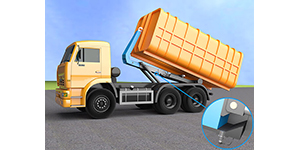Rugged inductive sensors prevent overloading of telescopic lifting arm on hooklift truck
 Summary:
Summary:
A hooklift truck utilizes a hydraulic system for loading and unloading a demountable container. The driver engages a lifting hook with the container before lifting it onto the vehicle’s load bed. Rugged sensor systems detect the position of the telescopic lifting arm prior to activating the lifting sequence, ensuring it is not extended. Sensors must be mechanically robust and withstand harsh outdoors conditions.
Art 117 Rugged inductive sensors prevent overloading of telescopic lifting arm on hooklift truckArt 117 Rugged inductive sensors prevent overloading of telescopic lifting arm on hooklift truck_Detail
Customer Values:
Elimination of human error by inhibiting lifting until arm is fully retracted
Highly reliable sensing performance in highly demanding conditions
Corrosion-resistant sensors withstand water, ice, mud and salt
Highly cost-effective solution to a potentially serious problem
Specific Product Advantages:
Single-piece AISI 303 (V2A) stainless-steel construction
Rugged, hermetically sealed embeddable sensors
High resistance to harsh operating conditions
Customer Application:
A specialist vehicle builder based in Switzerland manufactures hydraulic hooklift systems for commercial trucks. A hooklift truck employs a series of hydraulic rams to hook, lift and pull a demountable container onto the vehicle’s load bed. A full container may weigh up to 30 tons. Hooklift trucks operate all year round, often in harsh environments such as demolition and construction sites.
Hooklift systems are typically semi-automated. The driver positions the hook, which is mounted on a telescopic lifting arm, engages it with the container and initiates the lifting sequence. Before lifting, the extended section, which is immediately adjacent to the hook, must be fully retracted to avoid overloading the arm.
Before the lifting sequence can be enabled, a highly reliable sensor system must detect the position of the arm, ensuring that it is not extended. Sensors must be robust and must withstand water, mud, dirt and ice. They may also be subject to mechanical shock and vibration.
Customer Solution:
Designed for exceptionally demanding environments, rugged Full Inox inductive sensors from the Contrinex Extreme range are ideal for this application. Highly reliable and rated to IP68/IP69K, these embeddable units feature one-piece AISI 303 (V2A) stainless-steel construction with vacuum-encapsulated electronics, making them well suited to the hostile operating conditions.
Before initiating the lifting sequence, the hydraulic hooklift system retracts the telescopic arm, which is extended when the arm is stowed. An M18-diameter sensor is mounted in the housing of the extending section. The sensor detects the position of the arm once it is retracted. A 10 mm sensing distance eliminates any risk of accidental collision between adjacent moving parts.
Once the arm is correctly positioned, the lifting mechanism is enabled. The sensor is configured with an industry-standard PNP normally-open interface; connection to the control system is via integral M12 connectors and PUR-sheathed cables, allowing easy removal and replacement during routine maintenance.
Rugged sensor construction ensures excellent resistance to shock and vibration. Devices are corrosion-resistant and impervious to water ingress, mud, ice and salt. Reliability is excellent. Contrinex inductive sensors deliver a cost-effective solution that satisfies the customer’s requirements for a simple, fit-and-forget system.


